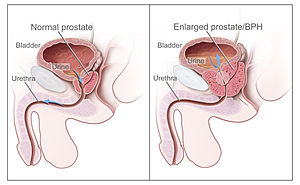[amazon_link asins=’B00XUZCSPC,B00KLRV1MI,0306458640,B0015R1VVY,B00B55WWT6,9962636329,0987676016,1466369256,1490484094′ template=’ProductCarousel’ store=’finmeacur-20′ marketplace=’US’ link_id=’ba6c0812-4b92-11e7-af4a-951098c77e36′]
It’s embarrassing. It’s annoying. It’s exasperating. And it’s controllable. We’re talking about the distressing inconvenience of the side effects associated with prostate problems. This often means midnight treks to the bathroom to pee, pain when you start and end urination and dribbling when you’re done. It can be frustrating when nothing you do seems to help, no matter how careful you try to be.
The key to controlling these symptoms is understanding what causes them, so you can learn how to cope and prevent them in the future.
The walnut-sized prostate gland is situated at the base of the bladder. The urethra runs from the bladder through the prostate and through the penis. As the prostate gets bigger, it constricts the flow of fluid through the urethra, contributing to several unpleasant and annoying symptoms:
*A need to urinate frequently during the night
*Urinating more often during the day
*Urinary urgency—a strong and sudden urge to pee
*Slow-to-start urine stream
*Lack of force in the urinary stream
*A slight stinging at the beginning and end of urination
*Urine “dribbling” some time after urination ends
*The sensation that the bladder hasn’t been emptied entirely
*The need to urinate again only a few minutes later
For the most part, these symptoms by themselves don’t require medical attention. They can often be controlled by certain urination management techniques that you can practice on your own. If the symptoms are particularly bothersome to you, consult a healthcare professional for help. In particular, you should seek medical care if you experience these symptoms:
*Inability to urinate
*Painful urination
*Blood in the urine
*Discharges from the penis other than urine
*Continuous or severe urinary incontinence
More often than not, using self-help management techniques and natural supplements such as saw palmetto, pumpkin seed, lycopene, red clover and nettle can help manage your prostate health. It’s important to remember that frequent urination, stinging and dribbling are often not a threat to your health or your life, although they can be awkward and embarrassing.
You may click to see :Prostrate Problems Blog
Non-Cancerous Prostate Problems:-
The following are some of the most common non-cancerous prostate problems, their symptoms, and treatment options:
1. Benign Prostatic Hyperplasia (BPH)
This problem occurs when the prostate gets enlarged. The prostate then blocks the urethra making it difficult to urinate. It causes a person to have a frequent urge to urinate and may cause urine to dribble. You need to see a doctor who will then conduct a rectal examination to diagnose the problem.
If your condition is not causing any problems, the doctor may advise annual checkups only. Treatment will be prescribed only if your situation gets worse later on. There are medications that can cause you prostate to shrink or can relax the muscles near the prostate. However, these medicines can cause side effects such as sexual problems, headaches, dizziness, or fatigue.
Surgery is usually advised only when the medications are not effective. Radio waves, Microwaves, and Lasers are used to treat BPH-related problems.
2. Acute Prostatitis
This condition is caused due to a bacterial infection of the prostate. It causes fever, chills, pain in the lower back, pain between legs, or pain while urinating. A host of medications are available to treat Prostatitis, but hey will be prescribed by your doctor. Do not take over the counter drugs.
3. Chronic Bacterial Prostatitis
This is a chronic condition caused by a bacterial infection. You may need to take antibiotics for a long time for the situation to improve. Even then, this infection may recur again and a recurrence is usually quite difficult to treat.
4. Chronic Abacterial Prostatitis
This condition is also known as Chronic Pelvic Pain Syndrome (CPPS). It causes pain in the lower back, at the tip of the penis, or between the legs. You may also have pain during sex or may need to urinate frequently. This situation is also hard to treat and may require more than one form of treatment.
Reources :
Better Health Research
Posts Tagged ‘Prostate
Related articles
- Homeopathic Remedies for Prostatitis Symptoms (homeopathy.suite101.com)
- Prostatitis – nonbacterial – chronic – All Information (umm.edu)
- How Does The Prostate Surgery Procedure Work? (mademan.com)
- Homeopathy for Prostatitis Symptoms (homeopathy.suite101.com)
- Are All Prostate Tumors Cancerous? (brighthub.com)
- Medication Options for Prostate Problems (everydayhealth.com)
- Burning and Bleeding After Urination (everydayhealth.com)
- Enlarged Prostate (BPH) May Cause Variety of Urinary Symptoms (seniors-health-medicare.suite101.com)
- Enlarged prostate – All Information (umm.edu)







![Reblog this post [with Zemanta]](https://i0.wp.com/img.zemanta.com/reblog_e.png?w=580)





 .
. .
.